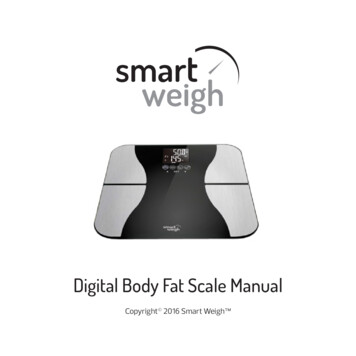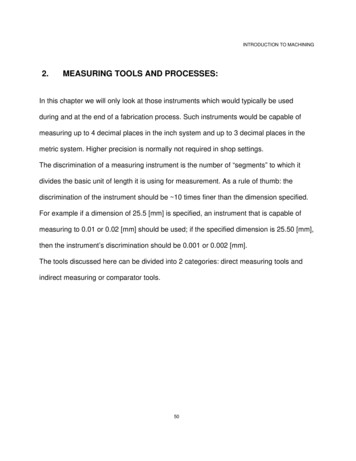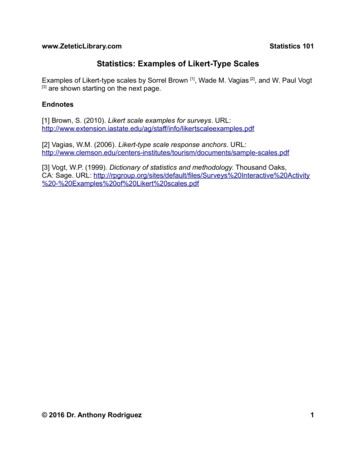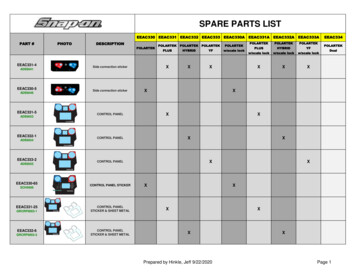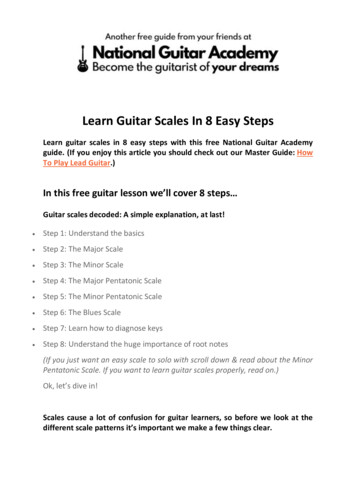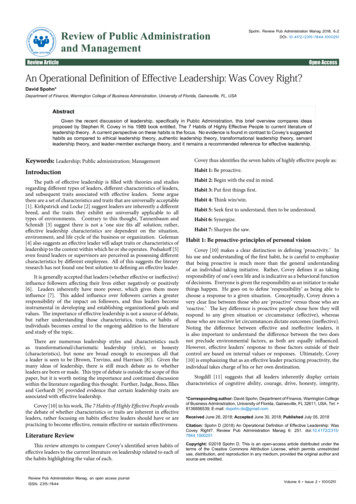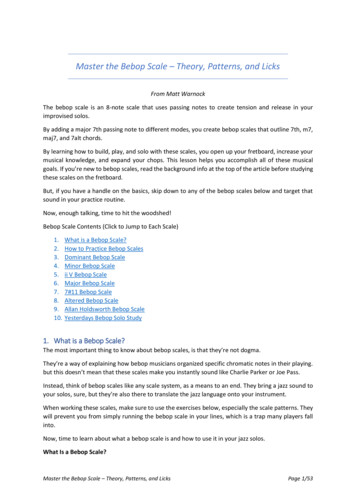
Transcription
Master the Bebop Scale – Theory, Patterns, and LicksFrom Matt WarnockThe bebop scale is an 8-note scale that uses passing notes to create tension and release in yourimprovised solos.By adding a major 7th passing note to different modes, you create bebop scales that outline 7th, m7,maj7, and 7alt chords.By learning how to build, play, and solo with these scales, you open up your fretboard, increase yourmusical knowledge, and expand your chops. This lesson helps you accomplish all of these musicalgoals. If you’re new to bebop scales, read the background info at the top of the article before studyingthese scales on the fretboard.But, if you have a handle on the basics, skip down to any of the bebop scales below and target thatsound in your practice routine.Now, enough talking, time to hit the woodshed!Bebop Scale Contents (Click to Jump to Each Scale)1.2.3.4.5.6.7.8.9.10.What is a Bebop Scale?How to Practice Bebop ScalesDominant Bebop ScaleMinor Bebop Scaleii V Bebop ScaleMajor Bebop Scale7#11 Bebop ScaleAltered Bebop ScaleAllan Holdsworth Bebop ScaleYesterdays Bebop Solo Study1. What is a Bebop Scale?The most important thing to know about bebop scales, is that they’re not dogma.They’re a way of explaining how bebop musicians organized specific chromatic notes in their playing.but this doesn’t mean that these scales make you instantly sound like Charlie Parker or Joe Pass.Instead, think of bebop scales like any scale system, as a means to an end. They bring a jazz sound toyour solos, sure, but they’re also there to translate the jazz language onto your instrument.When working these scales, make sure to use the exercises below, especially the scale patterns. Theywill prevent you from simply running the bebop scale in your lines, which is a trap many players fallinto.Now, time to learn about what a bebop scale is and how to use it in your jazz solos.What Is a Bebop Scale?Master the Bebop Scale – Theory, Patterns, and LicksPage 1/53
To keep things simple, here’s a definition of what a bebop scale is and what it does.Bebop scales use organized chromatic notes to bring tension and release to your solos.The first part of that sentence is very important. Often, beginner jazz guitarists use chromatic noteswherever they land under their fingers. Sometimes this works and sometimes it doesn’t.By learning bebop scales, you train your hands and ears to recognize where chromatic notes shouldbe added over various jazz chords. This brings a sense of chromaticism to your lines in a way thatsounds coherent, not random.Lastly, pay attention to the tension these scales bring to your jazz solos. If you don’t resolve thattension, created by the passing note(s), you sound like you made a mistake in your solo.While you don’t have to play the passing note on an off-beat, you do have to resolve that outsidenote to the next scale tone.The best thing to do when learning bebop scales is to go to the source. Listen to classic jazz albums andtranscribe bebop solos by great players such as Clifford Brown, Dizzy Gillespie, etc.This, combined with the fingerings in this lesson, is the most effective and efficient way to absorb thebebop sound into your playing2. How to Use Bebop ScalesAs you learn the fingerings in this lesson, you want to move beyond memorization in your guitarpractice routine. To help you make these scales more musical, here are two exercises to use with everybebop scale fingering. Work these exercises with one and two-octave shapes, examples of both areshown below.As well, practice each exercise with a metronome, with increased tempos over time. Then, move theseexercises around the fretboard as you take them to different keys in your study.Lastly, in the examples there’s one arpeggio shape being displayed for each scale exercise. To makethese scale exercises more effective, combine them with the appropriate one and two-octave guitararpeggio shapes.Arpeggio Up Scale Down 1 OctaveThe first exercise involves playing an arpeggio up and the scale down. It’s an example of a one-octaveC7 arpeggio with the C dominant bebop scale descending.Click to hear bebop scale exercises 1Master the Bebop Scale – Theory, Patterns, and LicksPage 2/53
Arpeggio Up Scale Down 2 OctaveHere’s the same arpeggio and scale written out over two-octaves.Click to hear bebop scale exercises 2Bebop Scale PatternsThe second exercise is to run scale patterns through any fingering that you learn in this lesson.This exercise is effective for building your knowledge of these shapes on guitar, and it adds to yoursoloing vocabulary at the same time.Here are examples of two different patterns over a D minor bebop scale. In both examples thearpeggio is played first, and then the pattern is used over the descending scale.This is an effective way to combine both the first and second exercises, killing two practice birds withone stone.Master the Bebop Scale – Theory, Patterns, and LicksPage 3/53
Bebop Scale Patterns 1 OctaveHere’s an example of a D minor bebop scale with an enclosure added to the root note of that scale.Enclosures are classic bebop vocabulary and adding them to the root note is a great place to beginyour study of this technique.Click to Hear bebop scale exercises 4Bebop Scale Patterns 2 OctaveIn the next example, you apply the Honeysuckle Rose pattern to a two-octave D minor bebop scale.This lick is built by adding the bebop passing note to the opening melody line of the jazz standard“Honeysuckle Rose.”This pattern won’t work great with the major bebop scale, but sits nicely on every other bebop scaleyou’ll learn in this lesson.Click to Hear bebop scale exercises 4Master the Bebop Scale – Theory, Patterns, and LicksPage 4/53
After you’ve memorized any one or two-octave scale shape, and practiced soloing over a jam track,run it through both of these exercises.Doing so helps you nail these fingering and provides you with vocabulary to add to your jazz guitarsolos at the same time. Now, on to learning how to play every bebop scale on guitar!3. Dominant Bebop ScaleThe first scale that you study is the dominant bebop scale, as it’s the most popular bebop scale usedin jazz and fusion.This scale is so popular that it’s often referred to as simply the bebop scale, even though there areother variations of the scale, as you learn below.Related to the 5th mode of the major scale, this scale is built by adding a major 7th passing tonebetween the b7 and root note of the Mixolydian mode.Here’s how those two scales compare as intervals.Mixolydian – R 2 3 4 5 6 b7Dom Bebop – R 2 3 4 5 6 b7 7Here’s how those two scales sound and look on the fretboard.Click to hear dom bebop scaleOnce you’ve listened to the above example, play both scales back to back to hear and seeing howthey’re related on the fretboard.As it’s directly related to the Mixolydian scale, this scale is used to solo over dominant family chords.Master the Bebop Scale – Theory, Patterns, and LicksPage 5/53
These dominant chords include:7th9th13thBecause of this, you find that the dominant bebop scale comes in handy when soloing over major ii VI’s, as well as jazz blues chord progressions.Now that you know how to build this scale, it’s time to learn how to play and solo with this importantjazz scale.Dominant Bebop Scale – 1 OctaveHere are 12 different one-octave scale shapes that you can use to practice this scale in all keys acrossthe fretboard.To begin, here are four one-octave shapes that start with your index finger. After you’ve learned anyof these fingerings, put on the C7 jam track and solo in your practice routine. Learning how to solowith bebop scales is just as important as memorizing them.So, make sure to divide your practice time between a metronome and jam track when studying these,and any, scale shapes.C7 Jam Track C7 Backing TrackMaster the Bebop Scale – Theory, Patterns, and LicksPage 6/53
Master the Bebop Scale – Theory, Patterns, and LicksPage 7/53
Here are four one-octave shapes that begin with your middle finger, with the exception of the 3rdstring root, which begins with your index finger.Master the Bebop Scale – Theory, Patterns, and LicksPage 8/53
Lastly, here are four shapes that begin with your pinky finger.One-octave shapes are essential when learning to solo over fast-moving chord changes.Even a jazz blues has two key changes in the first three bars, F7-Bb7-F7 for example, where one-octaveshapes allow you to move quickly between changes.When you have a few of these one-octave fingerings down, put on a jam track that has F7 for 1 barand Bb7 for 1 bar, moving between these chords in your lines.From there, change the key or add a third chord as you apply one-octave bebop scales to movingchords and full progressions in your studies.Master the Bebop Scale – Theory, Patterns, and LicksPage 9/53
Dominant Bebop Scale – 2 OctaveWhen you have more space to move around the fretboard, you want to have a two-octave scaleshapes under your fingers.Here are four different two-octave patterns that you can learn and solo with in your studies.Don’t forget, start with a metronome, then jam with over the C7 backing track with these shapes.C7 Jam Track C7 Backing TrackOnce you’ve learned a few of these longer shapes, put on a slow I-IV-V blues backing track and soloover each chord with its related two-octave scale shape.You won’t always have time to use these larger scale shapes, but when you do, they’re a great way tocover more area on the fretboard in your guitar solos.Master the Bebop Scale – Theory, Patterns, and LicksPage 10/53
3 Dominant Bebop Scale LicksHere are three classic bebop licks that you can learn and apply to your guitar solos.The first lick uses G dominant bebop to outline a G7 chord.Click to hear dominant bebop scales 1Here, you apply G dominant bebop to the V7 chord in a ii-V-I progression.Click to hear dominant bebop scales 2Lastly, here’s a lick that uses F and Bb dominant bebop over the first four bars of an F bluesprogression.Click to hear dominant bebop scales 3Once you’ve worked these licks out, write out three licks of your own to take this scale further in yourjazz guitar practice routine.Master the Bebop Scale – Theory, Patterns, and LicksPage 11/53
As dominant bebop is so popular, you want to spend the time to become comfortable with this scaleacross the fretboard.4. Minor Bebop ScaleIf you’ve done any reading on the minor bebop scale before today, you’ll know that there are twoversions of this scale.One version uses Dorian with a passing note between the b3 and 4th notes.The other version uses Dorian with a passing note between the b7 and root.I prefer to use the second version of this scale, and here’s why.When you use the passing note in the first version, 4-3-b3, you’re playing the same notes as thedominant bebop scale.Let me explain.If you’re soloing over Dm7 and G7, a ii V in C, you use D minor and G dominant bebop over thosechords.The G7 passing note is F#.With the first minor bebop version, the passing note would be F# as well.So, you only play one scale over both chords, G dominant bebop.Not that there’s anything wrong with that.But.If you want to bring a unique sound to each chord, ii and V, then the second minor bebop scale is theway to go.Here’s how Dorian and minor bebop look from an interval perspective.Dorian – R 2 b3 4 5 6 b7Minor Bebop – R 2 b3 4 5 6 b7 7Here are both of those scales on the fretboard to hear and see how they’re related.Play each scale to see how they sit on the fretboard, and how they compare from a fingeringstandpoint on the guitar.Click to hear minor bebop scaleMaster the Bebop Scale – Theory, Patterns, and LicksPage 12/53
Because the minor bebop and Dorian scales are so closely related, you can practice alternatingbetween them in your solos.Put on the Cm7 jam track and solo with both C minor bebop and C Dorian in your lines.This helps your ears become used to the difference that the bebop passing note makes when addedto the Dorian scale.Minor Bebop Scale – 1 OctaveNow that you know how to build this scale, and use it to solo over m7 chords, you’re ready to learnminor bebop on the guitar.To begin, here are 12 one-octave shapes that you can explore in your practice routine.After learning any of these one-octave shapes, put on the jam track below and solo over the Cm7chord in your practicing.Cm7 Jam Track Cm7 Backing TrackMaster the Bebop Scale – Theory, Patterns, and LicksPage 13/53
Master the Bebop Scale – Theory, Patterns, and LicksPage 14/53
Here are four one-octave shapes that begin with your middle finger.Master the Bebop Scale – Theory, Patterns, and LicksPage 15/53
Lastly, here are four shapes that begin with your pinky finger.If it’s comfortable, you can play the final fingering with your ring finger on the first note of that shape.When you have a few of these fingerings under your belt, put on a backing track that has Cm7 for 4bars and Dm7 for 4 bars and solo with these shapes.When that’s comfortable, narrow those changes down to two, then one bar each as you speed up thetransition time between chords in your solos.Minor Bebop Scale – 2 OctaveHere are four two-octave shapes that you can memorize and use in your solos when you have time tocover more fretboard space.Master the Bebop Scale – Theory, Patterns, and LicksPage 16/53
After learning any of these two-octave shapes, put on the Cm7 backing track and practice soloing overthat chord.Cm7 Jam Track Cm7 Backing TrackWhen you’ve got these fingerings down, put on a ii V jam track, such as Dm7 to G7 and solo over thosechords with both D minor and G dominant bebop.Start with four bars per chord at first.Then, speed things up to two bars, then one bar per chord, before finally moving between both chordswithin a single bar.Master the Bebop Scale – Theory, Patterns, and LicksPage 17/53
3 Minor Bebop Scale LicksArmed with a number of minor bebop fingerings, you’re ready to study essential minor bebop licks.The first lick uses D minor bebop to outline Dm7 over a two-bar line in the style of Pat Martino.Click to hear minor bebop scales 1Here, you apply D minor bebop to the iim7 chord in a ii-V-I in C major.Click to hear minor bebop scales 2Lastly, here’s a lick that uses C and F minor bebop over the first four bars of the Brazilian jazzstandard Blue Bossa.Click to hear minor bebop scales 3Once you’ve worked these licks out, write three minor bebop licks of your own to practice in a similarmanner.Master the Bebop Scale – Theory, Patterns, and LicksPage 18/53
As you can see, minor bebop brings a unique sound to your solos as compared to dominant bebop.5. ii V Bebop ScaleNow that you know both dominant and minor bebop on their own, you can combine them to createa ii V bebop scale.When doing so, you take the passing note from dominant bebop, major 7, and insert the passing tonefrom the related iim7 chord, the #4, into that same scale.To make it easier, think of this scale as Mixolydian with added major 7 and #4 passing tones.So, if you have C Mixolydian, you add the note B from dominant bebop.If you look at that as a V7 chord, then Gm7 would be the iim7 chord from that same key.The bebop passing note for Gm7 is F#.You then add that note to C Mixolydian to form the 9-note ii V scale.Here’s how the intervals line up on for the ii V bebop scale.ii V Bebop – R 2 3 4 #4 5 6 b7 7If that’s confusing, think of this scale as a combination of the iim7 and V7 bebop scales in any givenkey, starting from the V7 root.Here are C Mixolydian and C ii V bebop on the fretboard as a visual and audio aid to learning this scale.Click to hear ii V bebop scale 1After listening to the example, play Mixolydian and ii V bebop back to back to hear how they compareon the guitar.Master the Bebop Scale – Theory, Patterns, and LicksPage 19/53
If you want to take it further, play G Dorian followed by C ii V bebop to hear how those two scalescompare as well.ii V Bebop Scale – One OctaveYou can work on applying this theoretical knowledge directly to the fretboard.To begin, learn four one-octave ii V bebop fingerings beginning with your index finger.Here’s a Dm7 G7 jam track to help you practice this scale in your woodshedding.Dm7 G7 Jam Track Dm7 G7 Backing TrackMaster the Bebop Scale – Theory, Patterns, and LicksPage 20/53
The next group of scales is played from your middle finger, except the last one, which is played withyour index finger.Master the Bebop Scale – Theory, Patterns, and LicksPage 21/53
Lastly, here are four ii V bebop shapes that begin with the pinky finger, with the exception of the lastscale, which can be played from your ring finger if you prefer.After working this scale through a few one-octave fingerings, apply the exercises from the start of thislesson to take them further.To do so, play either the iim7 or V7 arpeggio up, then the scale down.As well, you can add scale patterns to these shapes in your workout.ii V Bebop Scale – Two OctaveAfter you’ve worked out a few one-octave fingerings, expand upon ii V bebop with two-octave shapes.Master the Bebop Scale – Theory, Patterns, and LicksPage 22/53
As is the case with any scale, memorize one shape and then take it to backing tracks in your solos.Here are four two-octave fingerings to get you started in the woodshed.Dm7 G7 Jam Track Dm7 G7 Backing TrackEven though it has 9 notes, you can work the ii V bebop scale through the exercises at the start of thislesson.Begin with the arpeggio up and scale down. When doing so, play either the iim7 or V7 arpeggio up,then the scale down.As well, adding in bebop patterns to this scale is a great way to bring a sense of the jazz language toyour phrases.Master the Bebop Scale – Theory, Patterns, and LicksPage 23/53
ii V Bebop Scale LicksHere are three ii V bebop licks to help you apply this scale to your own jazz guitar solos.The first lick uses ii V bebop to outline a short, ii V I progression in the key of C major.Click to hear ii V bebop scale 2The second ii V bebop lick expands on the previous phrase as you apply this scale to a longer ii V I in Cmajor.Click to hear ii V bebop scale 3To finish up your lick study, you can practice a line over the first four bars of a jazz blues in Bb.The scale is used to outline the Bb7 chord in the last two bars of the lick.Click to hear ii V bebop scale 4Master the Bebop Scale – Theory, Patterns, and LicksPage 24/53
When you want to bring a bit of chromatic tension to your ii V soloing lines, the ii V bebop scale isthe way to go.It takes a bit of time to become comfortable with this 9-note scale on the fretboard.But.With practice, you will nail this scale in your solos in no time.By adding this scale to your vocabulary, you’re able to add a bebop vibe to any minor family chord inyour jazz solos.6. Major Bebop ScaleComing out of the major scale, the major bebop scale is used to add a sense of tension and release toyour maj7 solos.To build major bebop, you add a #5 passing note to the major scale.Here’s how both of those scales compare in their interval makeup.Major Scale – R 2 3 4 5 6 7Major Bebop – R 2 3 4 5 #5 6 7Though it’s used to solo over maj7 chords, you want to treat major bebop in a different way than themajor scale.Because jazz standards often resolve to Imaj7 chords, the #5 interval prevents a Imaj7 chord fromsounding resolved.So, make sure to resolve the passing note so you don’t get caught creating tension over a Imaj7 chordwhen the ideal sound would be a resolved, non-chromatic line.To give you an idea of this comparison, here are Ionian and major bebop side by side on the fretboard.Click to hear major bebop scale 1Master the Bebop Scale – Theory, Patterns, and LicksPage 25/53
After listening to the example above, play these shapes back to back.This helps you visualize the relationship between Ionian and major bebop on the fretboard.Having this understanding makes it easier to move between these important maj7 scales in your jazzguitar solos.Major Bebop Scale – 1 OctaveNow that you know how to build major bebop, and apply it to your solos, it’s time to take this theoryto the fretboard.Here are 12 different one-octave shapes to practice major bebop across the fretboard.To begin, here are four one-octave shapes with your index finger on the root note.Check out any of these one-octave shapes, and as soon as you feel ready, solo with them over theCmaj7 jam track below.Cmaj7 Jam Track Cmaj7 Backing TrackMaster the Bebop Scale – Theory, Patterns, and LicksPage 26/53
Master the Bebop Scale – Theory, Patterns, and LicksPage 27/53
Here are four one-octave shapes that begin with your middle finger, except the 3rd-string root, whichbegins with the index finger.Master the Bebop Scale – Theory, Patterns, and LicksPage 28/53
Here are four shapes that begin with your pinky finger, with the exception of the last shape, which canbe played with your ring finger on the first note.After learning any of these one-octave fingerings, apply them to jazz standards. Start with a tune likeAutumn Leaves, or Take the A Train, and go from there.If you feel ready, use the major, minor, and dominant bebop scales in your solos over those sametunes.Master the Bebop Scale – Theory, Patterns, and LicksPage 29/53
Major Bebop Scale – 2 OctaveWith a good sense of the one-octave shapes, you’re ready to explore two-octave major bebop scalesin the woodshed.Here are four fingerings that you can learn, pick your favorites, and apply them to your technical andimprovisational practicing.As always, learn one shape with a metronome, and then jam on the Cmaj7 track below using thatsame two-octave fingering.Cmaj7 Jam Track Cmaj7 Backing TrackWhen you have these shapes under your fingers, mix them with minor and dominant bebop over a iiV I.Start with Dm7-G7-Cmaj7, and their related bebop scales, and move on to other keys from there.Master the Bebop Scale – Theory, Patterns, and LicksPage 30/53
To make things easier, playi 2 bars of Dm7, 2 bars of G7, and 4 bars of Cmaj7.Then, when that’s comfortable, pair it down to 1 1 2, and finally two bars total.This is tough to do at first. But, stick with it.Over time you become more confident switching between bebop scales over chord progressions.And that’s a very cool feeling.3 Major Bebop Scale LicksHere are 3 major bebop licks that you can learn and apply to popular chord progressions in thewoodshed.The first lick uses C major bebop to outline Cmaj7 in the most direct application of that scale in yoursolos.Click to hear major bebop scales 1Here, you solo with C major bebop over the Imaj7 chord in a ii-V-I progression in the key of C.Click to hear bebop scale 15Lastly, here’s a lick that uses C and Eb major bebop over the first four bars to “On Green DolphinStreet.”Click to hear major bebop scales 3Master the Bebop Scale – Theory, Patterns, and LicksPage 31/53
As you can see, major bebop brings a sense of tension and release to your maj7 phrases.Though it’s not as popular as the dominant, or even minor, scales, it’s worth working on and addingthis scale your maj7 lines.It expands your fretboard knowledge and expand your bebop vocabulary at the same time.Nothing wrong with that.7. 7#11 Bebop ScaleThe 7#11 bebop scale is built from one of the most popular melodic minor modes, the Lydian dominantscale.By adding a major 7 passing note to Lydian dominant, you create an 8-note scale that you use tooutline 7th chords in your solos.When doing so, you bring both a 7#11 sound to those chords, adding bebop scale tension and releasesounds to those same chords.Here are both scales from an interval standpoint.Lydian Dominant – R 2 3 #4 5 6 b7Lyd Dom Bebop – R 2 3 #4 5 6 b7 7To help you visualize these two scales, here they are on the fretboard from a C root note.Click to hear 7#11 bebop scale 1Master the Bebop Scale – Theory, Patterns, and LicksPage 32/53
Play through both scales as you see how they’re similar on the guitar but produce a unique sound alltheir own. When you’re comfortable, put on the C7 backing track solo with both Lydian dominant and7#11 bebop scales to hear how they sound over harmony.7#11 Bebop Scale – One OctaveNow that you know how to build this scale, you can learn how to play one-octave shapes for this scaleon guitar.As always, learn one shape from memory, and then jam with that shape over the track below.From there, take that shape to other keys before moving on to the next shape in your studies.To begin, here are four 7#11 bebop shapes starting from your index finger.C7 Jam Track C7 Backing TrackMaster the Bebop Scale – Theory, Patterns, and LicksPage 33/53
Master the Bebop Scale – Theory, Patterns, and LicksPage 34/53
Moving on, you can play the 7#11 bebop scale from your middle finger, except the last shape which isbetter with your index finger on the first note.Master the Bebop Scale – Theory, Patterns, and LicksPage 35/53
Lastly, here are four 7#11 shapes that you can learn from your pinky finger.Again, experiment with the last fingering as you may prefer to use your ring finger to begin that scaleshape.After you’ve worked out these fingerings, run them with 7th arpeggios up and the scale downAs well, pick a few bebop patterns to apply to these fingerings as you take them further in your studies.Master the Bebop Scale – Theory, Patterns, and LicksPage 36/53
7#11 Bebop Scale – Two OctaveYou’re now ready to expand these scales as you learn two-octave 7#11 bebop shapes on the guitar.Don’t forget to run these shapes with the jam track and work them with a metronome in differentkeys across the fretboard.C7 Jam Track C7 Backing TrackWhen these shapes are comfortable, combine them with 7th arpeggios and bebop patterns as youtake two-octave 7#11 bebop scales to the next level.Master the Bebop Scale – Theory, Patterns, and LicksPage 37/53
7#11 Bebop Scale LicksHere are 3, 7#11 bebop licks to learn and integrate into your guitar solos.The first lick uses the 7#11 bebop scale to color a C7 chord, the most direct application of this scale.Click to hear 7#11 bebop scale 2In this second 7#11 bebop lick, you outline the V7 chord in a C major ii V I progression.Click to hear 7#11 bebop scale 3To finish off, here’s 7#11 bebop being used to solo over each chord in the first four bars of a Bbblues chord progression.Click to hear 7#11 bebop scale 4After working the above licks as is, solo over those three progressions using 7#11 bebop in a similarfashion.Master the Bebop Scale – Theory, Patterns, and LicksPage 38/53
Though it may not be used as often as dominant bebop, 7#11 bebop opens new doors of creativity inyour playing.Give it a try, see how your ears welcome it into your playing, and have fun experimenting with thiscool, jazz scale.8. Altered Bebop ScaleYou now step into the minor key realm as you turn the 5th mode of harmonic minor into an 8-notebebop scale.By adding a major 7 passing tone to the Phrygian dominant scale, you create a scale that’s used tooutline a 7b9,b13 sound over 7th chords.You can use this altered bebop scale to solo over 7th chords, when adding tension to those changes,or more directly over 7alt chords.Here are the intervals for both scales to see how they’re related.Phrygian Dominant – R b2 3 4 5 b6 b7Altered Bebop – R b2 3 4 5 b6 b7 7This scale first came onto my radar after transcribing solos by the jazz trumpeter, Clifford Brown.Though there’s no real name for this scale, altered bebop fits the application, though it’s not directlyrelated to the altered scale.Because Phrygian dominant bebop scale is too long a title, and 7b9, b13 bebop is confusing; I preferthe name altered bebop scale.Here’s Phrygian dominant altered bebop back to back for comparison on the fretboard.Click to hear altered bebop scale 1Master the Bebop Scale – Theory, Patterns, and LicksPage 39/53
Play these scales back to back over the C7alt track as you experiment with this new sound over acommon jazz chord.Altered Bebop Scale – One OctaveNow that you know how to build and apply the altered bebop scale, it’s time to learn how to play thiscool-sounding scale.To begin, here are 12 one-octave shapes to study in the practice room.As well, you can use the C7alt jam track to work any of these shapes in the improvisational side ofyour practice routine.Starting off, here are four altered bebop shapes starting from the index finger.Master the Bebop Scale – Theory, Patterns, and LicksPage 40/53
C7alt Jam Track C7alt Backing TrackMaster the Bebop Scale – Theory, Patterns, and LicksPage 41/53
Next, you move on to working one-octave shapes from the middle finger, with the exception of thelast scale, which starts on your index finger.Master the Bebop Scale – Theory, Patterns, and LicksPage 42/53
Finally, here are four altered bebop scale shapes that begin with the first note played by your pinkyfinger.After you’ve worked on these scales, and jammed them over the C7alt track, take them to your minorii V I solos.These scales sound great when applied to the V7alt chord in a minor ii V I.So, give them a go and see how altered bebop elevates your minor key jazz soloing chops.Master the Bebop Scale – Theory, Patterns, and LicksPage 43/53
Altered Bebop Scale – Two OctaveHere are four two-octave altered bebop shapes that you can learn and use in your solos.Don’t forget to work these shapes with the backing track and with the metronome.When working on tense scales such as this, your ears absorb the new sound much quicker when youplay it over chords.So, make time for both technical and improvisational workouts with altered bebop.C7alt Jam Track C7alt Backing TrackAfter you work these scales on their own, apply the two exercises from the start of the lesson to theseshapes.To do so, you play up a C7 arpeggio then down altered bebop.Master the Bebop Scale – Theory, Patterns, and LicksPage 44/53
As well, apply many bebop patterns to these fingerings, especially enclosures.Altered Bebop Scale LicksHere are thr
Theory, Patterns, and Licks Page 9/53 . Lastly, here are four shapes that begin with your pinky finger. One-octave shapes are essential when learning to solo over fast-moving chord changes. Even a jazz blues has two key changes in the first three bars, F7-Bb7-F7 for example, where one
